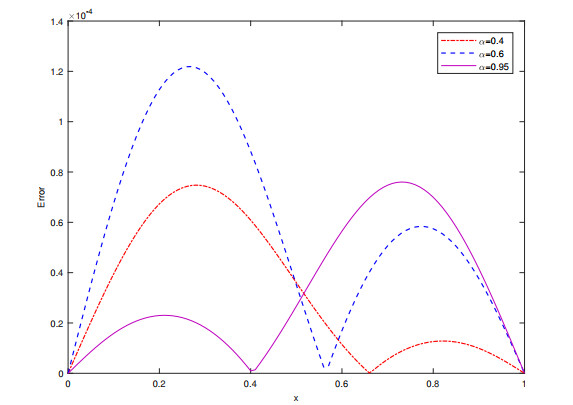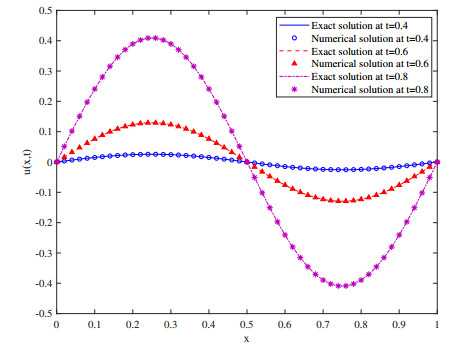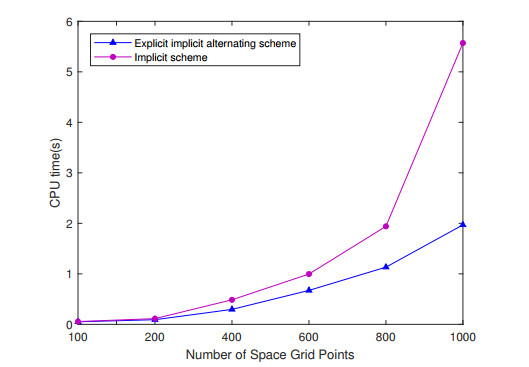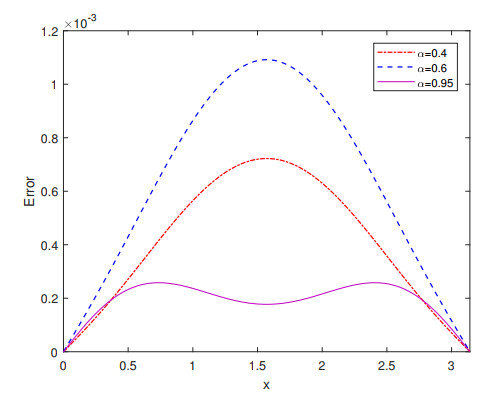1.
Introduction
An expedient feature of the p-Laplacian eigenvalue problem is that the eigenfunctions may be multiplied by constant factors (in other words, the fact that if u is an eigenfunction, so is ku). Unfortunately, the p(x)-Laplacian eigenvalue problem does not possess this expedient property. It is important to stress that the loss of the property under consideration is not only a consequence of the dependence on x, but it can also occur in presence of unbalanced growth. For example, the double phase operator (that does not depend on x)
loses this property. In this paper we are interested in considering that the operator has both peculiarities: It depends on x and it is unbalanced.
Let Ω⊂RN(N≥2) be a bounded domain with Lipschitz boundary ∂Ω. This article studies an eigenvalue problem coming from the minimization of the Rayleigh quotient:
among all u∈W1,Hn0(Ω),u≢0. These functions belong to an appropriate Musielak-Orlicz Sobolev space with variable exponents; see its definition in section two. The function a:ˉΩ→[0,+∞) is a C1 differentiable function.
Put
and define the first eigenvalue as
By a similar proof of Proposition 3.1 in [1], we can show that the following equation
is the Euler-Lagrange equation corresponding to the minimization of the Rayleigh quotient (1.2), where λ(pn(⋅),qn(⋅))=λ1(pn(⋅),qn(⋅)).
Here, we impose the following hypotheses on the variable exponents pn(x) and qn(x).
(H1): Assume that pn(x) and qn(x) are two sequences of C1 functions in ¯Ω, qn(⋅)>pn(⋅) for every n≥1 and
(H2): The following two quotients are bounded, namely,
where for a function g we denote
(H3): We also assume that
then we can find a positive and continuous function θ(0<θ<+∞), such that
uniformly for all x∈Ω.
The differential operator in (1.5) is the double-phase operator with variable exponents, which can be given by
This operator is the classical double phase operator (1.1) when pn(x) and qn(x) are constants. Moreover, special cases of (1.12), studied extensively in the literature, occur when inf¯Ωμ>0 (the weighted (q(x),p(x))-Laplacian) or when μ≡0 (the p(x)-Laplacian).
The energy functional related to the double-phase operator (1.12) is given by
whose integrand switches two different elliptic behaviors. The integral functional (1.13) was first introduced by Zhikov [2,3,4,5], who obtained that the energy density changed its ellipticity and growth properties according to the point in order to provide models for strongly anisotropic materials. Moreover, double phase differential operators (1.12) and corresponding energy functionals (1.13) have several physical applications. We refer to the works of [6] on transonic flows, [7] on quantum physics and [8] on reaction diffusion systems. Finally, we mention a recent paper that is very close to our topic. For related works dealing with the double phase eigenvalue problems, we refer to the works of Colasuonno-Squassina [9], who proved the existence and properties of related variational eigenvalues. By using the Rayleigh quotient of two norms of Musielak-Orlicz space, the author of this paper has defined the eigenvalue, which has the same properties as the p-Laplace operator. Recently, Liu-Papageorgiou has considered an eigenvalue problem for the Dirichlet (p,q(⋅))−Laplacian by using the Nehari method (see [10]), a nonlinear eigenvalue problem for the Dirichlet (p,q)−Laplacian with a sign-changing Carathéodory reaction (see [11]) and a nonlinear eigenvalue problem driven by the anisotropic (p(⋅),q(⋅))−Laplacian (see [12]). Motivated by [9], Yu[13] discuss the asymptotic behavior of an eigenvalue for the double phase operator. However, to the author's knowledge, the eigenvalue problem for variable exponents double phase operator has remained open. Our article fits into this general field of investigation.
Assume that δ:Ω→[0,∞) is the distance function, which is given by
This function is a Lipschitz continuous function. For all x∈Ω, we get |∇δ|=1. Define
It is known from the paper [1] that
Define
and
The following are the main results of this paper.
Theorem 1.1. Let u∈C(Ω) be a weak solution of problem (1.5), then it is also a viscosity solution of the problem (3.2).
Theorem 1.2. Let hypotheses (H1)–(H3) be satisfied, λ1(pn(⋅),qn(⋅)) and Λ∞ be defined by (1.4) and (1.14), respectively. In addition, assume that un normalized by ‖un‖Hn=1 is the positive first eigenfunction, then,
(1)
(2) there exists a nonnegative function u∞ such that u∞∈Cα(Ω)∖{0} and ||u∞||L∞(Ω)=1;
(3) we can extract a subsequence, which is still denoted by un, such that
in the space Cα(Ω), where α(0<α<1) is a constant;
(4) we can obtain that the function u∞(x) is a nontrivial viscosity solution of the problem
To the best of our knowledge, this is the first work dealing with the double phase eigenvalue problem (1.5). The rest of this paper is organized as follows. In section two, we collect some notations and facts about the Musielak-Orlicz space LH(Ω) and W1,H0(Ω), which will be used in this paper. Section three and section four are devoted to prove Theorems 1.1 and 1.2, respectively.
2.
Preliminaries
In this section, we recall some known results about the Musielak-Orlicz spaces LH(Ω) and W1,H0(Ω). For more detail, please see references [9,14,15,16,17].
We follow the notation of [9]. Let N(Ω) denote the set of all generalized N-functions. Let us introduce the nonlinear function H:Ω×[0,+∞)→[0,+∞) defined as
with 1<p(x)<q(x) and 0≤a(⋅)∈L1(Ω). It is clear that H∈N(Ω) is a locally integrable and generalized N-function. In addition, it fulfills the Δ2 condition, namely,
Therefore, in correspondence to H, we define the Musielak-Orlicz space LH(Ω) as
which can be equipped with the norm
where
which is called H-modular.
Similarly, we can define the Musielak-Orlicz Sobolev spaces. The space W1,H(Ω) is given by
with the norm
We denote by W1,H0(Ω) the completion of C∞0(Ω) in W1,H(Ω). With these norms, the spaces LH(Ω), W1,H(Ω) and W1,H0(Ω) are separable, reflexive and uniformly convex Banach spaces.
From Proposition 2.16 (ⅱ) in [18], if
then the following Poincareˊ-type inequality
holds for all u\in W_{0}^{1, \mathcal{H}}(\Omega) , where C is a positive constant independent of u . Therefore, in this paper, we equip W_{0}^{1, \mathcal{H}}(\Omega) with the equivalent norm \|\nabla u\|_{\mathcal{H}} for all u\in W_{0}^{1, \mathcal{H}}(\Omega) .
Proposition 2.1. [18] If u\in L^{\mathcal{H}}(\Omega) and \rho_{\mathcal{H}}(u) is the \mathcal{H} -modular, then the following properties hold.
(1) If\: u\neq0 , then \|u\|_{\mathcal{H}} = \lambda if, and only if, \varrho_{\mathcal{H}}(\frac{u}{\lambda}) = 1;
(2) \|u\|_{\mathcal{H}} < 1 \ ( = 1; > 1) if, and only if, \varrho_{\mathcal{H}}(u) < 1 \ ( = 1; > 1);
(3) If \|u\|_{\mathcal{H}} \leq 1 , then \|u\|_{\mathcal{H}}^{q^{+}} \leq \rho_{\mathcal{H}}(u)\leq \|u\|_{\mathcal{H}}^{p^{-}};
(4) If \|u\|_{\mathcal{H}} \geq 1 , then \|u\|_{\mathcal{H}}^{p^{-}} \leq \rho_{\mathcal{H}}(u)\leq \|u\|_{\mathcal{H}}^{q^{+}};
(5) \|u\|_{\mathcal{H}}\rightarrow 0 if, and only if, \rho_{\mathcal{H}}(u)\rightarrow 0;
(6) \|u\|_{\mathcal{H}}\rightarrow 0 if, and only if, \rho_{\mathcal{H}}(u)\rightarrow 0.
3.
The proof of Theorem 1.1
Given u\in C(\Omega)\bigcap W^{1, \mathcal{H}_{n}}_{0}(\Omega) and \phi\in C^{2}(\Omega) . Define
and
where \triangle_{\infty}\phi is the \infty -Laplacian.
Here, we are now in a position to give the following definition of weak solutions to problem (1.5).
Definition 3.1. We call u\in W^{1, \mathcal{H}_{n}}_{0}(\Omega)\backslash\{0\} a weak solution of problem (1.5) if
is satisfied for all test functions v \in W^{1, \mathcal{H}_{n}}_{0}(\Omega) . If u\neq 0 , we say that \lambda_{(p_{n}(\cdot), q_{n}(\cdot))} is an eigenvalue of (1.5) and that u is an eigenfunction corresponding to \lambda_{(p_{n}(\cdot), q_{n}(\cdot))} .
In (1.5), we replace u by \phi and keep S_{n} , K_{n} and k_{n} unchanged, then
We first recall the definition of viscosity solutions. Assume we are given a continuous function
where \mathcal{S}(N) denotes the set of N \times N symmetric matrices.
Consider the problem
where
Definition 3.2. Assume that x_{0}\in \Omega , u\in C(\Omega) , \psi\in C^{2}(\Omega) and \varphi\in C^{2}(\Omega) .
(1) Let u(x_{0}) = \psi(x_{0}) and suppose that u-\psi attains its strict maximum value at x_{0} . If
for all of such x_{0} , then the function u is said to be a viscosity subsolution of Eq (3.2).
(2) Let u(x_{0}) = \varphi(x_{0}) and suppose that u-\varphi attains its strict minimum value at x_{0} . If
for all of such x_{0} , then the function u is said to be a viscosity supersolution of Eq (3.2).
(3) If u is both a subsolution and a supersolution of the problem (3.2), then u is a viscosity solution of the problem (3.2).
Proof of Theorem 1.1. Claim: u is a viscosity supersolution of (3.2).
Let x_{0}\in \Omega and \varphi\in C^{2}(\Omega) . Assume that u(x_{0}) = \varphi(x_{0}) and the function u-\varphi obtains its strict minimum value at the point x_{0} . Our goal is to show that
If
then by continuity there exists a positive constant r such that B(x_{0}, 2r)\subset\Omega , u > \varphi in this ball, except for the point x_{0} and
for all x\in B(x_{0}, 2r) . Thus, if x\in B(x_{0}, r) , we have
If x\in \partial B(x_{0}, r) , the minimum value of the function u-\varphi is defined as m . Let \Phi(x): = \varphi(x)+\frac{m}{2} . Note that m > 0 and the above inequality still holds if the function \varphi(x) is replaced by \Phi(x) , namely,
Define \eta(x): = (\Phi-u)^{+}\geq0 , then if x\in \partial B(x_{0}, r) , we have \eta(x)\equiv0 .
Let
We multiply (3.5) by the function \eta(x) and integrate over B(x_{0}, r) , then the inequality
is true.
If we define
and use \eta_{1}(x) as a test function in (3.1), then we get
Subtracting (3.7) from (3.6), we arrive at
The first integral is nonnegative due to the elementary inequality
which holds for all p > 1 . Here, we take p = p_{n}(x) . We get a contradiction. Hence, (3.4) holds. Similarly, we conclude that u is a viscosity subsolution of (3.2) and we omit the details. □
4.
The proof of Theorem 1.2
Let n\in N be large enough such that p_{n}\geq r > N , which results in W_{0}^{1, \mathcal{H}_{n}}(\Omega)\hookrightarrow W_{0}^{1, r}(\Omega) (see Proposition 2.16 (1) of Blanco, Gasiński, Harjulehto and Winkert [18]). It follows that u_{n} are continuous functions. The reason is that the space W_{0}^{1, r}(\Omega)\hookrightarrow\hookrightarrow C^{\alpha}(\Omega) , 0 < \alpha < 1 . Moreover, it is known (see [9]) that for each n\in \mathbb{N} fixed, we have u_{n} > 0 .
In order to prove Theorem 1.2, we only need to prove the following conclusions.
Lemma 4.1. Let h:\overline{\Omega}\rightarrow (1, \infty) be a given continuous function, then
for all v \in W_{0}^{1, \mathcal{H}}(\Omega) and s\in (1, p^{-}) .
Proof. Since \left\|\frac{\nabla v}{||\nabla v||_{\mathcal{H}}}\right\|_{\mathcal{H}} = 1 , it follows from Proposition 2.1 that
Thus,
Invoking Proposition 2.1 again, we conclude that
which implies (4.1).
□
Lemma 4.2. If u\in L^{\infty}(\Omega) , then we have
Proof. Step1: To show that the following inequality holds,
If k_{n}(u)\leq k_{\infty}(u) , the above inequality is true. Thus, we can assume that k_{n}(u) > k_{\infty}(u) , and since q_{n}(x) > p_{n}(x) > 1 , we have
which implies (4.5) holds.
Step2: To show that the following inequality holds,
Case1: k_{\infty}(u) = 0 . It is easy to find that (4.6) holds.
Case2: k_{\infty}(u) > 0 . Given \varepsilon > 0 , there exists a nonempty set \Omega_{\varepsilon}\subset\Omega such that, for all x\in \Omega_{\varepsilon} , |u| > k_{\infty}(u)-\varepsilon . Ignoring those indices n that k_{n}(u)\geq k_{\infty}(u)-\varepsilon , we have
which gives
The arbitrariness of \varepsilon implies that (4.6) is true. Consequently, (4.4) holds.
□
Remark 4.1. If |\nabla u|\in L^{\infty}(\Omega) , we can argue as Lemma 4.2 to obtain that
Lemma 4.3. If the assumptions of Theorem 1.2 hold, then
(1) (1.18) holds;
(2) there exists a nonnegative function u_{\infty} such that u_{\infty}\in C^{\alpha}(\Omega)\setminus\{0\} and ||u_{\infty}||_{L^{\infty}(\Omega)} = 1;
(3) we can extract a subsequence, which is still denoted by u_{n} , such that
in the space C^{\alpha}(\Omega) , where \alpha \, (0 < \alpha < 1) is a constant.
Proof. Assume for simplicity that the following inequality holds
Step 1: To show that,
Inserting u(x) = \delta(x) into (1.4) gives
Note that by Lemma 4.2 and Remark 4.1, we have
Step 2: We now claim that u_{\infty}\in W_{0}^{1, \infty}(\Omega) .
Since (4.8) holds, for all n\in N sufficiently large, we can assume that \lambda^{1}_{(p_{n}(\cdot), \, q_{n}(\cdot))}\leq\Lambda_{\infty}+1 . Thus, we have
Note that the sequence \{||\nabla u_{n}||_{\mathcal{H}_{n}}\} is bounded.
Let r\in[1, \infty) be arbitrary. We can find an integer n_{r} , for all n\geq n_{r} , such that p_{n}(\cdot)\geq r and
Hence, the sequence \{u_{n}\} is bounded in the reflexive Banach space W_{0}^{1, r}(\Omega) . We can find a subsequence, still defined by \{u_{n}\} , and a function u_{\infty}\in W_{0}^{1, r}(\Omega) , such that \nabla u_{n}\rightharpoonup\nabla u_{\infty} in W_{0}^{1, r}(\Omega) and u_{n}\rightarrow u_{\infty} in L^{r}(\Omega) .
Define
and it follows that
and
Using Hölder's inequality and the above inequality, we have
Thus, (4.1) and (4.10) ensure that
We choose an arbitrary positive real number r_{1} such that B(x, r_{1})\subset\Omega , where the point x\in\Omega is a Lebesgue point such that |\nabla u_{\infty}|\in L^{1}(\Omega) , then we find that
Passing to the limit as r\rightarrow +\infty in the above inequality, gives
Letting r_{1}\rightarrow0^{+} in the above inequality, gives
for a.e. x\in\Omega , which implies that \nabla u_{\infty}\in L^{\infty}(\Omega) , as claimed.
Step 3: We want to prove that u_{n}\rightarrow u_{\infty} in C^{\alpha}(\Omega) ( 0 < \alpha < 1 ) and \|u_{\infty}\|_{L^{\infty}(\Omega)} = 1 .
Keeping in mind that r\in[1, \infty) is an arbitrary constant, we can assume that r > N . Therefore, this combined with the fact that W^{1, r}_{0}(\Omega)\hookrightarrow\hookrightarrow C^{\alpha}(\Omega)\, (0 < \alpha < 1) implies that there exists a nonnegative function u_{\infty}\in C^{\alpha}(\Omega)\setminus\{0\} , such that u_{n}\rightarrow u_{\infty} in C^{\alpha}(\Omega) and u_{n} converges uniformly to u_{\infty} in \Omega . Given \varepsilon\in(0, 1) , we can find a constant N_{\varepsilon}\in \mathbb{N} such that
for all x\in\Omega, n\geq N_{\varepsilon} . It follows that
and
for all n\geq N_{\varepsilon} . Letting n\rightarrow \infty in (4.14) and (4.15) yields
Thus, the inequality
holds. In view of Lemma 4.2 and (4.16), we can get
Step 4: To show that \liminf_{n\rightarrow \infty}\lambda^{1}_{(p_{n}(\cdot), \, q_{n}(\cdot))}\geq\Lambda_{\infty} .
Since \nabla u_{n}\rightharpoonup\nabla u_{\infty} in W_{0}^{1, r}(\Omega) , ||u_{n}||_{\mathcal{H}_{n}} = 1 and the inequality (4.11) holds, we have
Letting r\rightarrow \infty and using Proposition 7 in [19] and equality (4.17), we get
Thus, (4.8) and (4.18) imply that (1.18) holds. The proof is complete. □
Remark 4.2. We can again argue with Step 3 to obtain
The function u_{\infty}(x) also has the following property.
Lemma 4.4. If the assumptions of Theorem 1.2 hold, we can deduce that u_{\infty}(x) is a nontrivial viscosity solution of the problem (1.20).
Proof. For the first part we only need to show that u_{\infty} is a viscosity subsolution of (1.20). Let x_{0}\in \Omega and \psi\in C^{2}(\Omega) . Assume that u_{\infty}-\psi attains its strict maximum value of zero at x_{0} , namely, u_{\infty}(x_{0})-\psi(x_{0}) = 0 .
Claim: We want to show that
By Lemma 4.3, we know that the convergence of u_{n} to u_{\infty} in \Omega is uniform. Therefore, there exists a sequence \{x_{n}\}\subset \Omega such that x_{n}\rightarrow x_{0} (as n\rightarrow \infty ), u_{n}(x_{n}) = \psi(x_{n}) and u_{n}-\psi attains its strict maximum value at x_{n} .
Employing Theorem 1.1, it turns out that for any n\in \mathbb{N} large enough, u_{n} are continuous viscosity solutions of (1.5) with \lambda_{(p_{n}(\cdot), \, q_{n}(\cdot))} = \lambda^{1}_{(p_{n}(\cdot), \, q_{n}(\cdot))} . Thus, we have
Case 1: \psi(x_{0}) = u_{\infty}(x_{0}) > 0 .
Continuing (4.21), for n\in \mathbb{N} sufficiently large, we have |\nabla \psi(x_{n})| > 0 . Let us assume the assertion is not true, then by (4.21) and continuity, we have \psi(x_{0})\leq0 . This leads to a contradiction.
Dividing both sides of (4.21) by
we see that the following inequality holds
Now, letting n\rightarrow \infty , we deduce that
Taking the lower limit in inequality (4.22) and employing the limits above, we have
Note that by (4.17), (4.19) and u_{\infty}(x_{0}) = \psi(x_{0}) > 0 , we have
and
Claim:
Assume that \Lambda_{\infty}\psi(x_{0}) > |\nabla \psi(x_{0})| , then (4.24) and (1.11) imply
and
Thus, choosing \varepsilon > 0 small enough, we have
for all n\in \mathbb{N} sufficiently large. By (4.29), we get
From (4.23), (4.27) and (4.30), we see that
which is a contradiction. Hence, (4.26) holds.
Claim:
Suppose that the above inequality is not true, then we have
Thus, choosing \varepsilon_{1} > 0 small enough, we have
for all n\in \mathbb{N} sufficiently large. We are led to
In view of (\psi(x_{0}))^{\theta(x_{0})}K_{\infty}(u_{\infty})-|\nabla \psi(x_{0})| > 0 and (4.25),
Therefore, this fact along with (4.23) shows that (4.31) holds. This is a contradiction. Thus we deduce that (4.32) holds.
Claim:
Taking (4.24) and (4.26) into account, we have
At the same time, by (4.25) and (4.32), we also deduce that (4.36) holds. If we assume that inequality (4.35) does not hold, then by (4.23) and (4.36), there is a contradiction. Thus, we deduce that (4.35) holds.
Case 2: \psi(x_{0}) = u_{\infty}(x_{0}) = 0 .
Note that if |\nabla \psi(x_{0})| = 0 (in this case, we have \triangle_{\infty}\psi(x_{0}) = 0), the inequality (4.20) trivially holds. Hence, let us assume that |\nabla \psi(x_{0})| > 0 , then |\nabla \psi(x_{n})| > 0 for n\in \mathbb{N} large enough. We can use very similar arguments as Case 1 to conclude that (4.20) holds. The same argument can be used in order to show that u_{\infty} is a viscosity supersolution of (1.20). □
By Lemmas 4.3 and 4.4, it follows that Theorem 1.2 holds.
Remark 4.3. In the particular case where p_{n}(x) = np(x) and q_{n}(x) = nq(x) , Theorems 1.1 and 1.2 are also true.
5.
Conclusions
In this paper, we studied a double-phase eigenvalue problem with large variable exponents. As we know, for p -Laplace operator eigenvalue problems, there is an important feature that if u is an eigenfunction, so is ku , where k is an arbitrary constant. However, the double-phase operator with variable exponents looses this property. To overcome the above mentioned shortcoming, we defined the eigenvalue by using the Rayleigh quotient of two norms of Musielak-Orlicz space. Moreover, in the particular case where p_{n}(\cdot) = p_{n} and q_{n}(\cdot) = q_{n} , Theorems 1.1 and 1.2 are also true (see [13]).
Use of AI tools declaration
The authors declare they have not used Artificial Intelligence (AI) tools in the creation of this article.
Acknowledgments
This work was supported by the National Natural Science Foundation of China (No.12001196) and the Natural Science Foundation of Henan (No. 232300421143).
Conflict of interest
The authors declare that they have no competing interests.


















 DownLoad:
DownLoad: